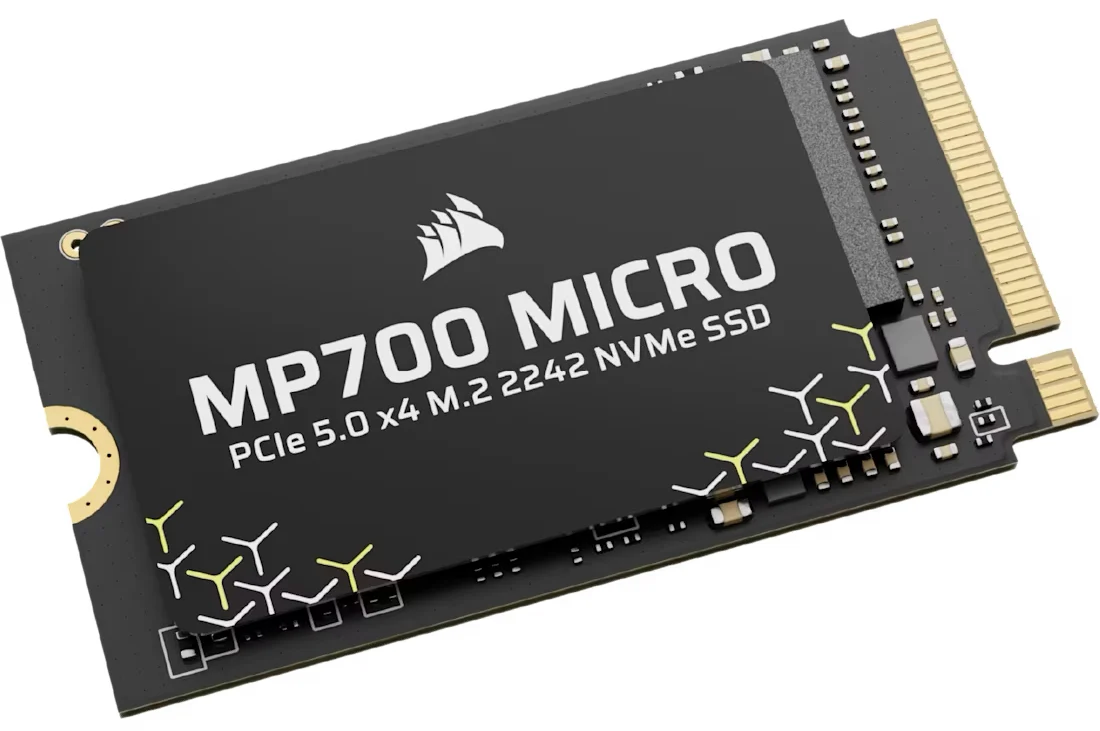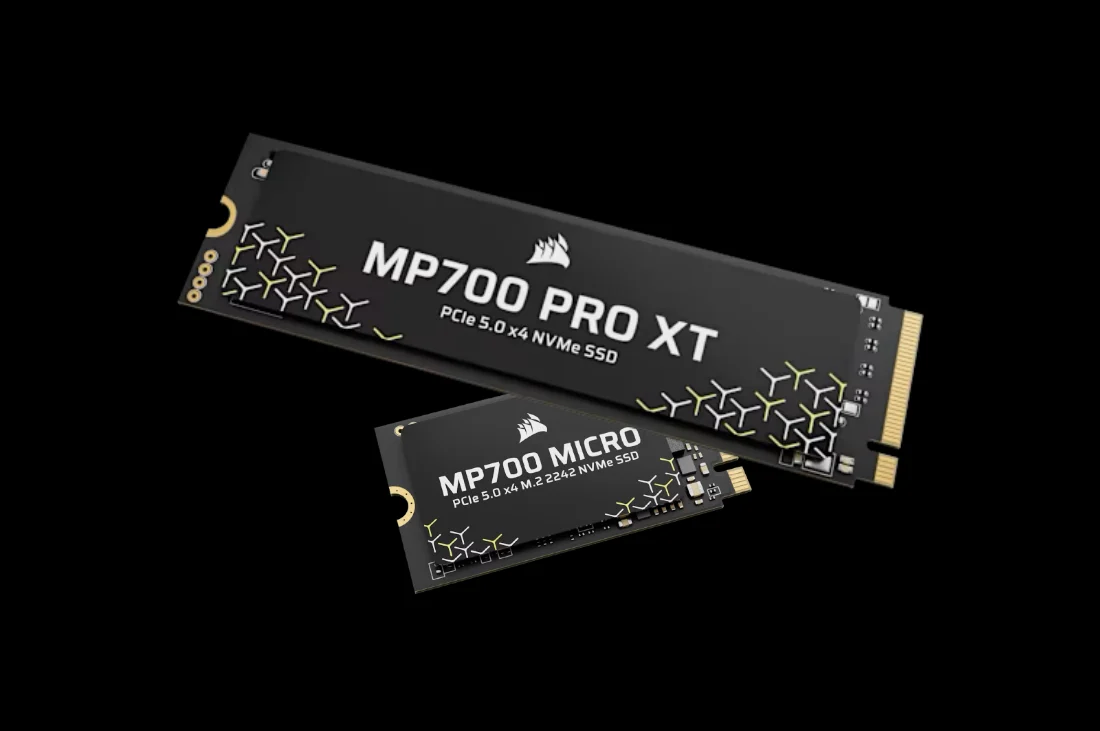Corsair has introduced two new PCIe 5.0 NVMe M.2 SSDs that target different segments of the consumer storage market. The MP700 PRO XT aims squarely at enthusiasts seeking maximum Gen5 performance, while the MP700 MICRO uses the 2242 (42mm) form factor to bring PCIe 5.0 speeds to compact systems and thin-and-light devices. Both drives became available on October 28, 2025.
MP700 PRO XT: Phison’s E28 Controller Delivers Peak Gen5 Performance

The flagship MP700 PRO XT represents Corsair’s fastest PCIe 5.0 offering to date. At its core sits Phison’s PS5028-E28 controller, a second-generation Gen5 platform built on TSMC’s 6nm process node. This allows the E28 to extract more performance while consuming less power than its 12nm predecessor, the E26. SSDs from several manufacturers are now launching with the E28 controller, including TeamGroup’s Z54E and PNY CS3250. We expect additional manufacturers to join in shortly.
Sequential read speeds reach up to 14,900 MB/s across all three capacity options of the MP700 PRO XT: 1TB, 2TB, and 4TB. Write performance varies slightly by model: the 2TB variant hits 14,500 MB/s, followed by the 4TB at 14,400 MB/s and the 1TB at 14,200 MB/s. Random performance remains consistent, with all capacities delivering 3,300,000 IOPS for writes. Random read performance scales with capacity, reaching 2,700,000 IOPS for the 2TB and 4TB models, while the 1TB version achieves 1,500,000 IOPS.
Corsair pairs the E28 controller with SanDisk’s BiCS8 218-layer TLC NAND operating at 2,400 MT/s. Despite using slower NAND than some competitors, the E28’s architecture compensates through its efficient design, which employs dedicated CoX processors for background tasks like garbage collection. This approach contrasts with competing controllers that rely on multiple ARM cores, often consuming more power in the process.
Power efficiency is the key improvement over earlier Gen5 drives in the consumer segment. The MP700 PRO XT draws an average of 8.5W during active use and drops below 5mW in the L1.2 idle state. Reviews of E28-based drives suggest this efficiency translates to cooler operation, with temperatures staying manageable even under sustained workloads when paired with a basic heatsink.
DirectStorage Support for Gaming
Microsoft’s DirectStorage API receives native support, enabling the drive to communicate directly with compatible GPUs. This feature can accelerate game load times and reduce stuttering during texture streaming. However, real-world benefits depend on game optimization and require a DirectX 12 GPU with Shader Model 6.0 support.
MP700 MICRO: Gen5 Performance in a Compact Package

While the PRO XT chases benchmark crowns, the MP700 MICRO solves a different problem: bringing PCIe 5.0 speeds to space-constrained systems. Its M.2 2242 form factor measures roughly half the length of standard 2280 drives, making it suitable for thin laptops and dense small-form-factor builds. It is however not compatible with the popular Steam Deck handheld, which requires the smaller 2230 form factor.
Inside the MP700 MICRO, you’ll find Phison’s PS5031-E31T controller, a DRAM-less design that uses Host Memory Buffer (HMB) technology instead of dedicated cache. Built on a 7nm process, the E31T prioritizes efficiency over absolute performance. The controller supports up to 8TB of TLC or QLC NAND running at speeds up to 3,600 MT/s across four channels.
Performance figures vary by capacity. The 2TB model achieves sequential reads up to 10,000 MB/s and writes up to 8,500 MB/s, while the 4TB version trades some speed for doubled storage, reaching 9,400 MB/s read and 8,100 MB/s write. Random performance remains consistent across capacities, with 1,300,000 IOPS for reads and 1,400,000 IOPS for writes.
The single-sided design aids thermal management. Under the copper foil-equipped label sits the controller and a single NAND package – either a 2TB or 4TB chip from Kioxia’s BiCS8 lineup. This configuration keeps heat generation low enough that Phison suggests the drive doesn’t require a heatsink for everyday computing tasks, though one remains a good choice for machines with sustained heavy workloads.
Technical Specifications
MP700 PRO XT Specifications
| MP700 PRO XT | 1TB | 2TB | 4TB |
|---|---|---|---|
| Controller | Phison PS5028-E28 | Phison PS5028-E28 | Phison PS5028-E28 |
| NAND Flash | SanDisk BiCS8 218-layer 3D TLC | SanDisk BiCS8 218-layer 3D TLC | SanDisk BiCS8 218-layer 3D TLC |
| Interface | PCIe 5.0 x4, NVMe 2.0 | PCIe 5.0 x4, NVMe 2.0 | PCIe 5.0 x4, NVMe 2.0 |
| Form Factor | M.2 2280 | M.2 2280 | M.2 2280 |
| DRAM Cache | Yes (SK Hynix) | Yes (SK Hynix) | Yes (SK Hynix) |
| Sequential Read | Up to 14,900 MB/s | Up to 14,900 MB/s | Up to 14,900 MB/s |
| Sequential Write | Up to 14,200 MB/s | Up to 14,500 MB/s | Up to 14,400 MB/s |
| Random Read IOPS | Up to 1,500,000 | Up to 2,700,000 | Up to 2,700,000 |
| Random Write IOPS | Up to 3,300,000 | Up to 3,300,000 | Up to 3,300,000 |
| Endurance (TBW) | 700 TB | 1,400 TB | 2,800 TB |
| Power Consumption (Avg) | 8.5W | 8.5W | 8.5W |
| Power Consumption (Idle L1.2) | <5mW | <5mW | <5mW |
| Warranty | 5 years | 5 years | 5 years |
| MSRP | $159.99 | $249.99 | $459.99 |
MP700 MICRO Specifications
| MP700 MICRO | 2TB | 4TB |
|---|---|---|
| Controller | Phison PS5031-E31T | Phison PS5031-E31T |
| NAND Flash | Kioxia BiCS8 218-layer 3D TLC | Kioxia BiCS8 218-layer 3D TLC |
| Interface | PCIe 5.0 x4, NVMe 2.0 | PCIe 5.0 x4, NVMe 2.0 |
| Form Factor | M.2 2242 | M.2 2242 |
| DRAM Cache | No (HMB) | No (HMB) |
| Sequential Read | Up to 10,000 MB/s | Up to 9,400 MB/s |
| Sequential Write | Up to 8,500 MB/s | Up to 8,100 MB/s |
| Random Read IOPS | Up to 1,300,000 | Up to 1,200,000 |
| Random Write IOPS | Up to 1,400,000 | Up to 1,400,000 |
| Endurance (TBW) | 1,200 TB | 2,400 TB |
| Power Consumption (Max) | 6.1W | 6.1W |
| Power Consumption (Idle) | 3.5mW | 3.5mW |
| Warranty | 5 years | 5 years |
| MSRP | $209.99 | $484.99 |
Current Competitors
Other than direct competition with other Phison E28-based SSDs like the PNY CS3250 and TeamGroup T-Force Z54E, E28-based drives compete with SSDs using Silicon Motion’s SM2508 controller, such as the Micron 4600 and Acer Predator GM9000, as well as Samsung’s proprietary Presto controller found in the 9100 Pro.
Early benchmarks from independent reviewers suggest the E28 excels in random workload scenarios, which matter more for everyday computing than synthetic sequential tests. In PCMark 10’s Full System Drive test, E28-based drives scored notably higher than competing Gen5 platforms.
The MP700 MICRO faces less direct competition. Few manufacturers offer PCIe 5.0 drives in the 2242 form factor, particularly at 4TB capacities. Most compact gaming handhelds and ultraportable laptops still ship with PCIe 4.0 drives or smaller 2230 Gen5 options. Corsair’s decision to offer a 4TB model in this form factor addresses a minor but existing gap in the market.
Corsair prices the MP700 PRO XT at $159.99 for 1TB, $249.99 for 2TB, and $459.99 for 4TB. These figures place it competitively within the premium Gen5 segment at roughly $0.16 per gigabyte for the 1TB model and around $0.11 per gigabyte for the 4TB variant.
The MP700 MICRO commands a premium for its compact design: $209.99 for 2TB and $484.99 for 4TB. That translates to approximately $0.10 and $0.12 per gigabyte, respectively.
Both drives ship with Corsair’s SSD Toolbox management software and carry five-year limited warranties. Additional capacity options for the PRO XT line are expected in early 2026, though Corsair hasn’t specified this exactly.
Both the MP700 PRO XT and MP700 MICRO are available now through Corsair’s website and authorized retailers worldwide.
Source: Corsair’s official press release
